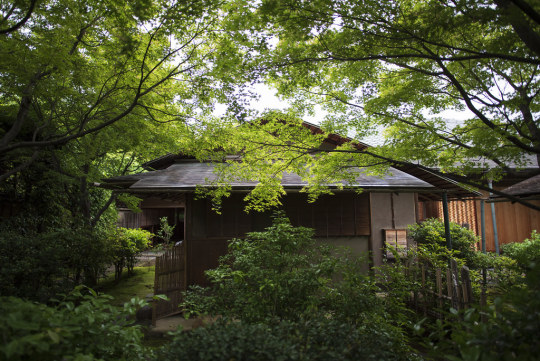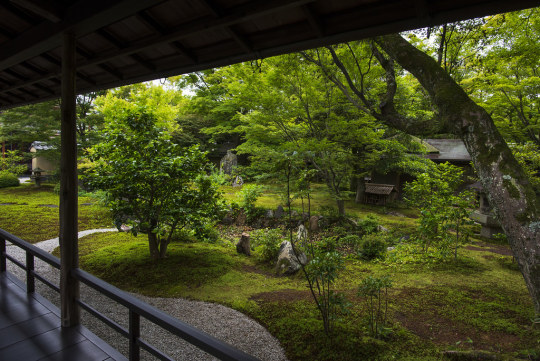#Ōbai-in 黄梅院
Photo

Ōbai-in 黄梅院 by Patrick Vierthaler
46 notes
·
View notes
Text
Takeda Shingen’s daughters
Ōbai-in (黄梅院) - 1543 - 1569; real name unknown
mother: Sanjō no kata
In 1553 during the process of forming the Imagawa-Takeda-Hōjō alliance, it was decided she is going to be married to the eldest son of Hōjō Ujiyasu, Ujimasa. The following year she moved to Odawara. She was 12 years old.
A year later she gave a birth to Ujimasa’s son, but he died prematurely. Next year she bore him a daughter. In 1562, she gave birth to Ujimasa’s her Ujinao and in following years to his other sons. It is thought that their husband-wife relationship was good (because the number of children is a proof apparently).
However in 1568 when Shingen invaded Suruga, the alliance was broken. Ujiyasu was furious and sent Ōbai-in back to Shingen. She became a nun and died following year at a young age. She was 26.
When Takeda and Hōjō became allies again in 1571, Ujimasa built a Ōbai-in in a Hōjō clan’s Sōun temple and put some of her ashes in there.
Kenshō-in (見性院) - ? - 1622; real name unknown
mother: Sanjō no kata
In 1558, she was married to a son of Shingen’s sister, Anayama Nobutada. In 1572, she gave birth to his son, Katsuchiyo, who later became known as Takeda Nobuharu.
Nobutada betrayed the Takeda, surrendered to the Tokugawa and fought against Katsuyori. During the Honnōji incident, he was together with Ieyasu in Kyoto, but both of them were returning separated ways and Anayama Nobutada was killed. Katsuchiyo became the head of the family, but he also died early in 1587 because of illness. The Anayama family was inherited by
Kenshō-in continued living with the Tokugawa and later she was given a residence in Kita no maru in Edo castle. She raised an illegitimate son of Tokugawa Hidetada and his lover Shizu, Yukimatsu, later known as Hoshina Masayuki.
Shinryū-in (真竜院、眞龍院) - 1550 - 1647; real name unknown, popularly known as Marihime (真理姫)
mother: either Sanjō no kata or Lady Aburakawa
In 1555, when Kiso Yoshiyasu surrendered to Shingen, Shingen gave his daughter to his son Yoshimasa, because the Kiso clan protected important bases of his territory. In 1577, she gave Yoshimasa an heir, future Kiso Yoshitoshi.
But when Oda Nobunaga started his elimination of Takeda clan in 1582, Yoshimasa separated from Takeda Katsuyori and joined Nobunaga. Because of that, the Takeda forces executed some of their children in Sunpu castle that were there as hostages. Mari separated from her husband and lived together with he third son in seclusion.
Yoshimasa was transfered to Shimosa province and her son Yoshitoshi was reproved from killing his uncle and lost his rank. It’s said he went to live with his mother after that.
There’s a letter left that Mari wrote where she’s pitying the state of the clan she once married into.
She died at the age of 97.
Taigi-in (大儀院) - 1558 (1563?) - 1604; real name Kiku
mother: Lady Aburakawa
In 1578/1579 her brother Takeda Katsuyori made an alliance with Uesugi Kagaketsu who was in the middle of a succession conflict with Uesugi Kagetora. As a symbol of this alliance, Kiku was married to Uesugi Kagekatsu in 1579. After the marriage she was called Kōshū-fujin (Kōshū = different name for Kai province) or Kai-goryōnin by the Uesugi retainers and was loved and respected by them as a woman blessed by beauty and intelligence that encouraged frugality.
Thanks to her influence, Takeda Nobukiyo was allowed to come and serve the Uesugi clan, after the Takeda clan was destroyed and starting from the second generation, the Takeda clan was treated with politeness by the Uesugi.
In 1589, Hideyoshi ordered all daimyō to send a hostage to Kamigata, so Kiku together with Kagekatsu and his men paid homage to Hideyoshi. Since then, she lived in the Uesugi mansion in Kyoto. She was exchanging gifts and correspondence with women from noble families. According to a “History of Myōshinji temple”, she was devoutly mourning her brother Katsuyori there.
In 1595 she moved into Uesugi’s residence in Fushimi where she was joined by Osen, Naoe Kanetsugu’s wife.
In the Winter of 1603, she fell ill and died next year in Fushimi. She never went back to Echigo, never visited Aizu nor Yonezawa. It is said that Kagekatsu and the Uesugi retainers felt very sad upon hearing about her death. She never had children.
Shinshōni (信松尼) 1561 - 1616; real name Matsu
mother: Lady Aburakawa
Matsuhime is famous for being engaged to Oda Nobutada, Nobunaga’s heir. After Katsuyori’s wife, Nobunaga’s adopted daughter died, to continue the alliance a marriage was agreed upon between Matsu (6yo) and Nobutada (10yo).
The alliance was however broken in 1572 and so was their engagement, but neither of the two forget about the other. It’s said they fell in love through exchanging letters.
After Shingen’s death, Matsu went to live with her brother Nishina Morinobu (Shingen’s 5th son) in Takatō castle. In 1582 when Oda forces were attacking, she first escaped to Sunpu castle and then to Hachiōji castle. After the Takeda was destroyed, Matsu got an invitation from Oda Nobutada and they were finally scheduled to meet, however Honnōji happened and Nobutada died.
Matsu became a nun a prayed for Nobutada and Takeda clan’s souls. In 1590, she moved close to the Hachiōji castle. It’s said she was teaching kids how to read and write in a school connected to the temple, growing silkworm, and making textile to get some sort of income.
Together with her sister Kenshō-in, she helped with raising Hidetada Tokugawa’s son, Hoshina Masayuki.
She became a heart and support of many former Takeda vassals that were concentrated around Hachiōji castle.
It’s mainly for my own reference. There could be misunderstandings.
11 notes
·
View notes
Photo

Ōbai-in 黄梅院 by Patrick Vierthaler
16 notes
·
View notes